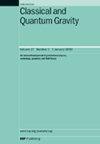黑洞与宇宙视界的合并
IF 3.6
3区 物理与天体物理
Q2 ASTRONOMY & ASTROPHYSICS
引用次数: 0
摘要
近年来,基于Emparan和Martínez的模型,对精确可解的黑洞合并进行了许多研究,其中一个黑洞的质量被膨胀到无穷大(Emparan和Martínez 2016 Class)。量子重力。33 155003)。在这里,我们用宇宙视界代替大黑洞,并通过考虑一个位于未来零无穷大的观测者,研究它如何与史瓦西-德西特时空中的黑洞合并。我们描述了视界随时间的几何形状,包括焦散在合并过程中所起的作用,并研究了视界面积的增长。我们认为在零宇宙常数的极限下,系统约化为Emparan-Martínez史瓦西合并。这使我们能够规范合并期间面积的增加,否则面积会分散。本文章由计算机程序翻译,如有差异,请以英文原文为准。
The merger of a black hole with a cosmological horizon
In recent years there have been many studies on exactly solvable black hole mergers, based on a model by Emparan and Martínez where the mass of one black hole is blown up to infinity (Emparan and Martínez 2016 Class. Quantum Grav.33 155003). Here we replace the large black hole by a cosmological horizon, and study how it merges with a black hole in the Schwarzschild-de Sitter spacetime by considering an observer positioned at future null infinity. We describe the geometry of the horizon over time, including the role that caustics play in the merger process, and also examine the growth of the horizon area. We argue that in the limit of zero cosmological constant, the system reduces to the Emparan-Martínez Schwarzschild merger. This allows us to regularize the increase in the area during the merger, which otherwise diverges.
求助全文
通过发布文献求助,成功后即可免费获取论文全文。
去求助
来源期刊

Classical and Quantum Gravity
物理-天文与天体物理
CiteScore
7.00
自引率
8.60%
发文量
301
审稿时长
2-4 weeks
期刊介绍:
Classical and Quantum Gravity is an established journal for physicists, mathematicians and cosmologists in the fields of gravitation and the theory of spacetime. The journal is now the acknowledged world leader in classical relativity and all areas of quantum gravity.
 求助内容:
求助内容: 应助结果提醒方式:
应助结果提醒方式:


